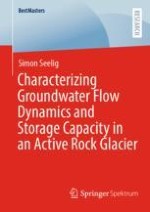2022 | Buch
Über dieses Buch
Alpine aquifers play a critical role in the hydrology of mountainous areas by sustaining base flow in downstream rivers during dry periods and retarding flood propagation after heavy precipitation events. Progressing climate change alters climatic and meteorological boundary conditions as well as the hydraulic response of alpine catchments by ablating glaciers and thawing permafrost. Rock glaciers exert a controlling influence on the catchment response due to their prominent groundwater storage and complex drainage characteristics. This thesis investigates the hydrogeology and internal structure of the active rock glacier Innere Ölgrube (Ötztal Alps), which governs catchment runoff and is affected by permafrost degradation. A 3D geometrical model of its internal structure is obtained by combining geophysical data and permafrost creep modelling. Available data and new results are integrated into a conceptual hydrogeological model providing a sound basis for the implementation of a prospective numerical groundwater flow model. Hydraulic properties of the hydrostratigraphic units constituting the rock glacier are estimated and groundwater recharge fluxes quantified. Fundamental properties of the heterogeneous groundwater flow system within the rock glacier are discussed and compared to existing rock glacier studies.
Anzeige
